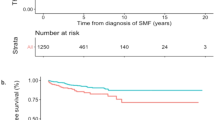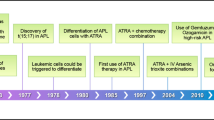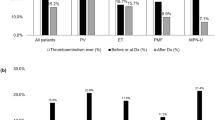Abstract
Although the occurrence of thrombosis in acute promyelocytic leukemia (APL) has been reported during retinoic acid treatment, no studies carried out in large clinical cohorts have specifically addressed this issue. We analyzed 124 APL patients treated with the all-trans retinoic acid and idarubicin protocol and compared clinico-biologic characteristics of 11 patients who developed thrombosis with those of 113 patients who had no thrombosis. In seven patients, the events were recorded during induction, whereas in four patients deep vein thrombosis occurred in the post-induction phase. Comparison of clinico-biological characteristics of patients with and without thrombosis revealed in the former group higher median white blood cell (WBC) count (17 × 109/l, range 1.2–56, P=0.002), prevalence of the bcr3 transcript type (72 vs 48%, P=0.01), of FLT3-ITD (64 vs 28%, P=0.02), CD2 (P=0.0001) and CD15 (P=0.01) expression. No correlation was found with sex, age, French-American-British subtype, all-trans-retinoic acid syndrome or with thrombophilic state that was investigated in 5/11 patients. Our findings suggest that, in APL patients consistent biologic features of leukemia cells may predict increased risk of developing thrombosis.
This is a preview of subscription content, access via your institution
Access options
Subscribe to this journal
Receive 12 print issues and online access
$259.00 per year
only $21.58 per issue
Buy this article
- Purchase on Springer Link
- Instant access to full article PDF
Prices may be subject to local taxes which are calculated during checkout
Similar content being viewed by others
References
Sanz MA, Jarque I, Martin G . Acute promyelocytic leukaemia therapy: results and prognostic factors. Cancer 1988; 1: 7–13.
Tallman MS, Kwaan HC . Reassessing the hemostatic disorder associated with acute promyelocytic leukaemia. Blood 1992; 79: 543–553.
Dombret H, Scrobohaci ML, Ghorra P, Zini JM, Daniel MT, Castaigne S et al. Coagulation disorders associated with acute promyelocytic leukemia: corrective effect of all-trans retinoic acid treatment. Leukemia 1993; 7: 2–9.
Barbui T, Finazzi G, Falanga A . The impact of all-trans retinoic acid on the coagulopathy of acute promyelocytic leukaemia. Blood 1998; 91: 3093–3102.
Runde V, Aul C, Heyll A, Schneider W . All-trans retinoic acid: not only a differentiating agent but also an inducer of thromboembolic events in patients with M3 leukemia. Blood 1992; 79: 534–535.
Tallman MS, Lefebvre P, Baine RM, Shoji M, Cohen I, Green D et al. Effects of all-trans retinoic acid or chemotherapy on the molecular regulation of systemic blood coagulation and fibrinolysis in patients with acute promyelocytic leukaemia. J Thromb Haemostasis 2004; 2: 1341–1350.
Runde V, Aul C, Sudhoff T, Heyll A, Schneider W . Retinoic acid in the treatment of acute promyelocytic leukemia: inefficacy of the 13-cis isomer and induction of complete remission by the all-trans isomer complicated by thromboembolic events. Ann Hematol 1992; 64: 270–272.
de Lacerda JF, do Carmo JA, Guerra ML, Geraldes J, de Lacerda JM . Multiple thrombosis in acute promyelocytic leukaemia after tretinoin. Lancet 1993; 342: 114–115.
Hashimoto S, Koike T, Tatewaki W, Seki Y, Sato N, Azegami T et al. Fatal thromboembolism in acute promyelocytic leukemia during all-trans retinoic acid therapy combined with antifibrinolytic therapy for prophylaxis of hemorrhage. Leukemia 1994; 8: 1113–1115.
Escudier SM, Kantarjian HM, Estey EH . Thrombosis in patients with acute promyelocytic leukemia treated with and without all-trans retinoic acid. Leuk Lymphoma 1996; 20: 435–439.
Goldschmidt N, Gural A, Ben Yehuda D . Extensive splenic infarction, deep vein thrombosis and pulmonary emboli complicating induction therapy with all-trans-retinoic acid (ATRA) for acute promyelocytic leukemia. Leuk Lymphoma 2003; 44: 1433–1437.
De Stefano V, Sora F, Rossi E, Chiusolo P, Laurenti L, Fianchi L et al. The risk of thrombosis in patients with acute leukemia: occurrence of thrombosis at diagnosis and during treatment. J Thromb Haemostasis 2005; 3: 1985–1992.
Mandelli F, Diverio D, Avvisati G, Luciano A, Barbui T, Bernasconi C et al. Molecular remission in PML/RAR alpha-positive acute promyelocytic leukemia by combined all-trans retinoic acid and idarubicin (AIDA) therapy. Gruppo Italiano-Malattie Ematologiche Maligne dell'Adulto and Associazione Italiana di Ematologia ed Oncologia Pediatrica Cooperative Groups. Blood 1997; 90: 1014–1021.
Diverio D, Riccioni R, Pistilli A, Buffolino S, Avvisati G, Mandelli F et al. Improved rapid detection of the PML/RARalpha fusion gene in acute promyelocytic leukemia. Leukemia 1996; 10: 1214–1216.
Chomczynski P, Sacchi N . Single-step method of RNA isolation by acid guanidinium thiocyanate-phenol-chloroform extraction. Ann Biochem 1987; 162: 156–159.
van Dongen JJ, Macintyre EA, Gabert JA, Delabesse E, Rossi V, Saglio G et al. Standardized RT-PCR analysis of fusion gene transcripts from chromosome aberrations in acute leukemia for detection of minimal residual disease. Report of the BIOMED-1 Concerted Action: investigation of minimal residual disease in acute leukemia. Leukemia 1999; 13: 1901–1928.
Noguera NI, Breccia M, Divona M, Diverio D, Costa V, De Santis S et al. Alterations of the FLT3 gene in acute promyelocytic leukemia: association with diagnostic characteristics and analysis of clinical outcome in patients treated with the Italian AIDA protocol. Leukemia 2002; 16: 2185–2189.
Avvisati G, ten Cate JW, Buller JW, Mandelli F . Tranexamic acid for control of haemorrhage in acute promyelocytic leukemia. Lancet 1989; 2: 122–124.
Sanz MA, Lo Coco F, Martin G, Avvisati G, Rayon C, Barbui T et al. Definition of relapse risk and role of nonanthracycline drugs for consolidation in patients with acute promyelocytic leukemia: a joint study of the PETHEMA and GIMEMA cooperative groups. Blood 2000; 96: 1247–1253.
Springer TA . Adhesion receptors of the immune system. Nature 1990; 346: 425.
Seya T, Tejima H, Fukuda H, Hara T, Matsumoto M, Hatanaba M et al. Acute promyelocytic leukaemia with CD59 deficiency. Leuk Res 1993; 17: 895–896.
Claxton DF, Reading CL, Nagarajan L, Tsujimoto Y, Andersson BS, Estey E et al. Correlation of CD2 expression with PML gene breakpoints in patients with acute promyelocytic leukaemia. Blood 1992; 80: 582–586.
Guglielmi C, Martelli MP, Diverio D, Fenu S, Vegna ML, Cantu-Rajnolidi A et al. Immunophenotype of adult and childhood acute promyelocytic leukaemia: correlation with morphology, type of PML gene breakpoint and clinical outcome. A cooperative Italian study on 196 cases. Br J Haematol 1998; 102: 1035–1041.
Albano F, Mestice A, Pannunzio A, Lanza F, Martino B, Pastore D et al. The biological characteristics of CD34+CD2+ adult acute promyelocytic leukemia and the CD34-CD2- hypergranular and microgranular phenotypes. Haematologica 2006; 91: 311–316.
Di Noto R, Schiavone EM, Ferrara F, Manzo C, Lo Pardo C, Del Vecchio L . Expression and ATRA-driven modulation of adhesion molecules in acute promyelocytic leukemia. Leukemia 1994; 8: 1900–1905.
Thomas X, Anglaret B, Campos L, Thiebaut A, Sabido O, Bailly M et al. Expression of beta1-integrins and pseudo-immunoglobulins on acute promyelocytic leukaemia cells and its modifications during in vitro differentiation. Leuk Res 1998; 22: 61–68.
Paietta E . Expression of cell-surface antigens in acute promyelocytic leukaemia. Best Pract Res Clin Haematol 2003; 16: 369–385.
Di Noto R, Lo Pardo C, Schiavone EM, Ferrara F, Manzo C, Vacca C et al. All-trans retinoic acid and the regulation of adhesion molecules in acute myeloid leukemia. Leuk Lymphoma 1996; 21: 201–209.
Noguera N, Breccia M, Divona M, Diverio D, Costa V, De Santis S et al. Alterations of the FLT3 gene in acute promyelocytic leukemia: association with diagnostic characteristics and analysis of clinical outcome in patients treated with the Italian AIDA protocol. Leukemia 2002; 16: 2185–21889.
Gale RE, Hills R, Pizzey AR, Kottaridis PD, Swirsky D, Gilkes AF et al. NCRI Adult Leukemia Working Party. Blood 2005; 106: 3768–3776.
Gilliland DG, Griffin JD . The roles of FLT3 in hematopoiesis and leukaemia. Blood 2002; 100: 132–1542.
Marasca R, Maffei R, Zucchini P, Castelli I, Saviola A, Martinelli S et al. Gene expression profiling of acute promyelocytic leukaemia identifies two subtypes mainly associated with FLT3 mutational status. Leukemia 2006; 20: 103–114.
Tallman MS, Andersen JW, Schiffer CA, Appelbaum FR, Feusner JH, Shepherd L et al. All trans retinoic acid in acute promyelocytic leukaemia. N Engl J Med 1997; 337: 1021–1028.
Di Bona E, Avvisati G, Castaman G, Vegna ML, De Sanctis V, Rodeghiero F et al. Early haemorrhagic morbidity and mortality during remission induction with or without all-trans retinoic acid in acute promyelocytic leukaemia. Br J Hematol 2000; 108: 689–695.
Castaigne S, Chomienne C, Daniel MT, Ballerini P, Berger R, Fenaux P et al. All-trans retinoic acid as a differentiation therapy for acute promyelocytic leukemia. Clinical results. Blood 1990; 76: 1704–1709.
Fenaux P, Castaigne S, Dombret H . All trans retinoic acid as first line therapy of acute promyelocytic leukaemia. A report on 31 cases. Br J Haematol 1991; 77 (Suppl 1): (abs 126), p 44.
Tsukada N, Wada K, Aoki S, Hashimoto S, Kishi K, Takahashi M et al. Induction therapy with all-trans retinoic acid for acute promyelocytic leukaemia: a clinical study of 10 cases, including a fatal case with thromboembolism. Intern Med 1996; 35: 10–14.
Pogliani EM, Rossini F, Casaroli I, Maffe P, Corneo G . Thrombotic complications in acute promyelocytic leukemia during all-trans retinoic acid therapy. Acta Haematol 1997; 97: 228–230.
Author information
Authors and Affiliations
Corresponding author
Rights and permissions
About this article
Cite this article
Breccia, M., Avvisati, G., Latagliata, R. et al. Occurrence of thrombotic events in acute promyelocytic leukemia correlates with consistent immunophenotypic and molecular features. Leukemia 21, 79–83 (2007). https://doi.org/10.1038/sj.leu.2404377
Received:
Revised:
Accepted:
Published:
Issue Date:
DOI: https://doi.org/10.1038/sj.leu.2404377
Keywords
This article is cited by
-
Cancer-associated thrombosis in hematologic malignancies
International Journal of Hematology (2024)
-
Simplified predictive scores for thrombosis and bleeding complications in newly diagnosed acute leukemia patients
Thrombosis Journal (2023)
-
Multi-omics and machine learning reveal context-specific gene regulatory activities of PML::RARA in acute promyelocytic leukemia
Nature Communications (2023)
-
Risk factors of thrombosis in Chinese subjects with acute promyelocytic leukemia
Thrombosis Journal (2021)
-
Advances in the diagnosis and treatment of disseminated intravascular coagulation in haematological malignancies
International Journal of Hematology (2021)



